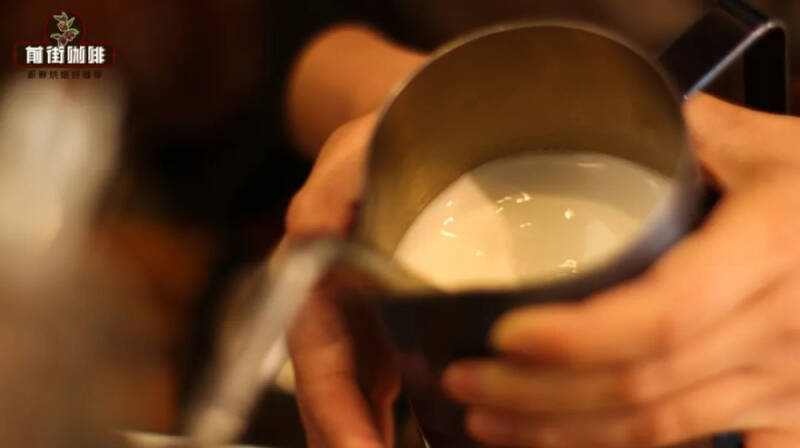Why are lattes made with low-temperature fresh milk? What is the difference between fresh milk and pure milk?
If we want to get a good cup of Italian milk coffee, then in addition to the concentrated base to have a good performance, the right choice of milk is also essential. After all, in addition to blending with coffee and diluting its concentration, milk can also make coffee sweeter and more mellow. At the same time, the substances in the milk can also build bubbles, adding a dense touch to the milk coffee. And there are many kinds of milk on the market, such as full fat, skim, purification and so on. In spite of this, no matter where it is, which cafe in any city, as long as you have no special requirements, the default milk they use to make milk coffee is almost all full-fat fresh milk. So many friends will wonder why cafes use full-fat fresh milk.

To know this answer, we need to know how milk affects a cup of coffee.
How does milk affect a cup of coffee? Milk is rich in all kinds of substances! Things like protein, carbohydrates, fat, and gray matter are the main components of milk. Because of their different characteristics, each of them can bring different benefits to coffee. Protein: the protein in milk is mainly composed of whey protein and casein. When we dispense with milk bubbles, they are important contributors to the formation of stable bubbles.

Whey protein forms a film that wraps the gas when the steam enters the milk, and then evolves into bubbles of different sizes, while casein covers the surface of the bubble, which forms a certain degree of surface tension between the bubble and the liquid. Let the bubble have a more stable barrier, reduce the phenomenon of rupture.
Carbohydrates: the carbohydrates of milk are mainly lactose, the sweetness of lactose is not obvious, it is not like fructose, its sweetness can be clearly perceived by our taste buds, because the sweetness is not so high. If the sweetness of sucrose is 1.0, then the sweetness of lactose is only 0.16, which is very different. However, its sweetness will be affected by the temperature.
The range of 60 °C ~ 70 °C is when lactose and other sugars are most "active", and the sweetness of lactose in this temperature range can be perceived more obviously. So generally speaking, part of the reason we send milk to this temperature is to "activate" the sweetness of lactose and make hot milk cafes taste sweeter.
Fat: in milk, the content of fat determines the thickness of alcohol. We can clearly experience this in skim milk. Friends who have drunk skimmed milk will know that compared with conventional whole milk, skimmed milk tastes thinner, even some light, this is the impact of fat loss!
Fat can not only improve the taste, but also play a certain role in the formation of milk bubbles. When the milk is heated to 40 °C, the lipids in the milk will be melted, and the density of the melted lipids is light and thin, which can be easily adsorbed on the surface of the bubble, and the outer shell of the foam can be "reinforced" again to make its defoaming speed slower. But for skim milk, due to the reduction of fat, the foam is missing a strong shell, so it is used to pull flowers, the foam will break more easily, and the speed of defoaming will be greatly accelerated. So we can know why coffee shops don't use skim milk to make milk coffee.
So, is it better to have as many of these substances in milk? In theory, the higher the concentration of the substance in the milk, the stronger the flavor of the milk itself, which is really a good thing from a bystander's point of view. However, everything should be in the right amount! When the concentration of various substances is too high, the rich taste of milk can easily mask the taste of coffee, such as purified milk! Whether it is lactose, fat, or protein, its content will be higher than whole milk, although the taste and taste will be thicker, but this kind of milk is not all good for regular milk coffee making!
In boutique coffee shops, no matter what kind of milk coffee is, the taste of milk will not outweigh the taste of coffee, either a balance will be achieved, or coffee will be more prominent. If the taste of milk exceeds that of coffee, then we will taste like a cup of coffee-flavored milk, which not only tastes out of balance, but also tastes very different. Therefore, when we make milk coffee, if we use purified milk, but do not adjust the ratio of it to coffee, then the taste of milk will be too strong, the taste will directly overshadow the coffee! Although this will be more friendly to some friends who do not like bitter taste, for most people, it is putting the cart before the horse.
In addition, the right amount of protein and fat can really improve the foaming and stability of milk. But when the fat content is too high, although the taste will be more mellow, but its dissolved weight will be more than the thin milk foam can bear, so under the heavy pressure of thick fat, the milk foam will soon disintegrate. Foam aside, if we want to give play to the advantages of purified milk, we have to adjust or dilute the original scheme. But in this way, the price is expensive and the operation is tedious, which is typically thankless. Therefore, in addition to the specified requirements, or some specific coffee products, it is almost impossible to choose purified milk for production. On the other hand, full-fat milk perfectly meets the requirements of milk coffee, neither overflow of milk taste due to high concentration of substance, nor thinness of taste due to lack of substance.
Different types of whole milk should know that whole milk is also different, mainly due to the difference produced by sterilization process. At present, there are two most common kinds of whole milk, one is fresh milk that needs to be refrigerated, and the other is UHT normal temperature milk, which can be stored at room temperature. Maybe you are not familiar with the name of this milk. If we say "pure milk", you must be very familiar with it. The difference between the two lies in the use of different sterilization methods, you know, freshly collected milk can not be drunk directly, because it contains a lot of bacteria, direct drinking is easy to cause disease, so generally speaking, milk will be sterilized before it is sold.
As we mentioned, the two kinds of milk are sterilized by pasteurization (fresh milk) and UHT ultra-high temperature sterilization (normal temperature milk). Because the sterilization methods are different, the retention of fungi and various nutrients is also different. The temperature of UHT ultra-high temperature sterilization is 135C ~ 150C, and the sterilization time is 2-5 seconds. The advantage of this is that the bacteria can be completely eliminated, thus greatly extending the shelf life of milk, which can be stored at room temperature for 6 months or more. But the downside is that the heat not only kills bacteria, but also takes away some of the milk's substances, such as fat, so it tastes less full, but the foam lasts longer.
Pasteurization is carried out at a "low temperature" of 70 °C ~ 75 °C, which allows nutrients to be retained to the maximum extent, so the taste and taste will be better. But this is the result of shortening the shelf life! Frozen fresh milk can only be stored for about two weeks, and the ambient temperature can only be kept at a low temperature. Once beyond this period of time, or in a high-temperature environment for a long time, it is easy to produce qualitative change.
For friends who make coffee at home, both are fine, and there is no obvious difference without direct comparison. But for coffee shops, taste and taste are supreme, even if there is only a slight difference, in their eyes, it's the difference between 60 and 90. Therefore, most businesses will use fresh milk stored at low temperature to make milk coffee, mainly in order to make their products have better performance.
-END-
Important Notice :
前街咖啡 FrontStreet Coffee has moved to new addredd:
FrontStreet Coffee Address: 315,Donghua East Road,GuangZhou
Tel:020 38364473
- Prev

Lock three houses in one day! Kudi Associate: I can't hold it, I won't play anymore!
▲ Click to pay attention| Daily Boutique Coffee Culture Magazine Coffee Factory "The coffee industry opened 89346 new stores in the past year, with a net increase of 48508 stores. "Data as of April 8 reveals that competition in the industry is becoming increasingly fierce. To break through among many competitors, each brand needs some new ones.
- Next

What is Chili Rose Summer Coffee? Is Aji bourbon or Geisha? Do the dividing line manor chili beans have the flavor of chili?
At the beginning of this month, the 2024 WBC World Barista Competition came to a successful conclusion. The championship prize was won by Mikael Jasin from Asia and Indonesia. His self-selected coffee beans in the finals took advantage of the trend, and a variety called "Chili Aji" even attracted many coffee people in an instant
Related
- What effect does Italian American coffee with filter paper have? Will coffee taste better if it is put on filter paper at the bottom of the powder bowl?
- What is the color difference in coffee beans? What are the characteristics of honey processed coffee beans? Why are the anaerobically treated coffee beans uneven in color?
- How does novice Xiaobai quickly get started and make coffee? Newbies learn to make coffee by hand and share the specific steps and process process!
- Costa tea has a shelf life of 100 years?! Expert: Unable to verify
- It's a huge uproar! American milk addition was rejected by Manner employees?!
- Mocha pot coffee bean recommendations| How fine and how much powder should be used for grinding? What parameter ratios do I need to use to make milk with Mocha pot coffee?
- What are the characteristics of the world's top ten coffee beans treated with Costa Rica honey? How to make black honey kadura from Tarazhu Pilon Processing Plant taste good?
- How to make deep-roasted coffee? What grinding water temperature does authentic Jamaica Blue Mountain No. 1 coffee use to brew it well?
- Selected high-grade rose summer coffee flavor tasting guide Why Panama rose summer has the aroma of flowers and fruits
- What equipment does a novice Xiaobai need to buy to learn to make coffee? Filter cup electronic scale bean grinder manual flushing pot purchase guide

